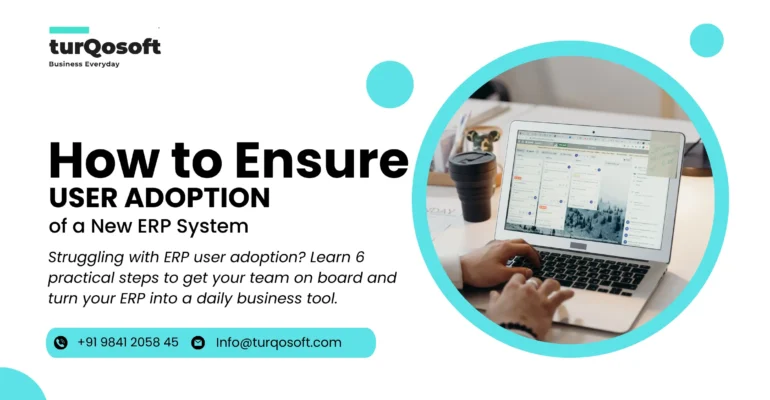How to Ensure User Adoption of a New ERP System

A powerful ERP system is only as good as the people using it.
It’s a hard truth many Indian businesses discover too late. They invest time and money into implementing ERP software—only to find their teams still clinging to spreadsheets, WhatsApp threads, and outdated habits.
According to a Panorama Consulting report, up to 70% of ERP implementations fail to deliver expected results—mainly because teams don’t use the system as intended. The tech works. The people don’t. Yet.
So how do you make sure your team actually uses the new ERP system?
In this post, you’ll learn why user adoption matters, what usually blocks it, and six practical steps to help get every department on board—plus how to keep the momentum going after launch.
Why User Adoption Matters in ERP Implementation
Rolling out ERP software isn’t just a tech upgrade—it’s a team-wide shift. And if people don’t use it, even the best ERP can turn into expensive shelfware.
What’s at stake?
- Wasted time, money, and IT effort
- Bad data and broken workflows
- Delayed returns and frustration at the top
But if user adoption is strong, you’ll see:
- Better decisions, backed by real data
- Smoother operations across departments
- Faster returns on your ERP investment
Even the best ERP won’t help unless your team is actually using it.
Common Barriers to ERP User Adoption
Even well-designed ERP systems face pushback. Here’s why adoption often stalls:
Lack of Training and Onboarding
If users don’t know how the system works—or how it helps them—they’ll go back to what’s familiar.
Resistance to Change
Change is hard. People don’t like switching up their routine unless they see a clear benefit.
Overcomplicated Interfaces or Workflows
When ERP systems feel cluttered or confusing, users get overwhelmed and frustrated.
Poor Communication from Leadership
If no one explains what the system does or why it matters, the team won’t care enough to try.
6 Proven Strategies to Ensure User Adoption
Start simple. Build buy-in. And make the system easier—not harder—to use. Here’s how:
Start Early
Get users involved before you launch. Ask for feedback during setup. Let them test and suggest changes. This creates a sense of ownership.
Communicate the Why
People follow purpose. Show how the ERP helps each role. Will it reduce double work? Shorten approval times? Speed up billing? Make that clear.
Simplify Workflows
Clean up the interface. Remove extra fields. Set up views for each department. If a task takes fewer clicks, people will do it.
Train, Then Retrain
Host short, role-specific training sessions. Follow up with quick videos and cheat sheets. Make support ongoing—not one and done.
Assign Power Users
Pick a few team members to go deep on the system. These people become go-to helpers others trust.
Follow Up
Watch system use. Ask questions. Offer help where needed. Adoption isn’t a one-time push—it’s a steady nudge.
Takeaway: Change takes time.
But the right nudges help it stick.
How to Support Long-Term Adoption After Go-Live
Once you go live, don’t assume your job is done. Keep supporting your team. Here’s how:
- Support Channels: Open a helpdesk, a group chat, or a quick contact form where people can ask questions without hassle.
- Gather Feedback: Ask what’s working and what’s not. Then act on it.
- Connect ERP Use to KPIs: If sales teams use the system, log that data. If finance runs reports, track that too.
- Create Quick Reference Docs: Make a library of how-to guides and short videos.
- Celebrate Milestones: Track usage and highlight wins—like “100% of invoices are now logged in ERP.”
Ongoing adoption is about Support, not Pressure.
Conclusion
ERP software doesn’t create value on its own. People do.
If your team understands the purpose, gets the training, and sees real-world benefits, they’ll use it. And when they do, your system works. Your processes flow. Your data makes sense.
Need help getting there?
👉 Book an ERPNext Demo and let our team show you how adoption becomes action.
Alternatively, you can stay updated with the latest insights on LinkedIn, YouTube, Facebook, Twitter, Pinterest, or Instagram
Your ERP can do the work. Let’s help your people get there.


